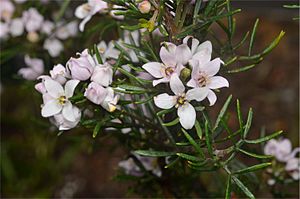Mt Arthur boronia facts for kids
Quick facts for kids Mt Arthur boronia |
|
|---|---|
 |
|
| Boronia hemichiton in the Royal Tasmanian Botanical Gardens | |
| Conservation status | |
| Scientific classification | |
 |
|
| Occurrence data from Australasian Virtual Herbarium |
The Mt Arthur boronia (scientific name: Boronia hemichiton) is a special plant found only in Tasmania, Australia. It belongs to the citrus family called Rutaceae. This plant is a type of woody shrub that stands upright. It has leaves made up of several smaller leaflets and pretty pink or white flowers with four petals.
What it Looks Like
The Mt Arthur boronia is an upright, woody shrub. It can grow to be about 1.5 metres (5 feet) tall. Its branches have tiny, stiff hairs and small, rounded glands.
The leaves of this plant are quite interesting. Each leaf has three, five, or seven smaller leaflets. The whole leaf is usually about 9 to 12 millimetres (0.35-0.47 inches) long and 12 to 16 millimetres (0.47-0.63 inches) wide. It sits on a small stalk called a petiole, which is about 1.5 to 2.5 millimetres (0.06-0.10 inches) long. The leaflet at the very end is 2.5 to 8 millimetres (0.10-0.31 inches) long and 0.5 to 1 millimetre (0.02-0.04 inches) wide. The leaflets on the sides are similar but a bit longer.
The flowers are usually pink, but sometimes they can be white. They grow either by themselves or in small groups of up to three. These groups appear where the leaves join the stem, in an area called a leaf axil. The small stalk holding the flower group is 1 to 2 millimetres (0.04-0.08 inches) long.
Each flower has four narrow, triangle-shaped sepals. These sepals are about 0.5 to 1.5 millimetres (0.02-0.06 inches) long and 0.5 millimetres (0.02 inches) wide. The four petals are shaped like narrow eggs with a pointed tip. They are about 4.5 to 5.5 millimetres (0.18-0.22 inches) long and 1.2 to 3 millimetres (0.05-0.12 inches) wide. The outside of the petals is hairy.
Mt Arthur boronia flowers bloom from October to January. After flowering, it produces a smooth, hairless fruit. This fruit is a capsule about 2.5 to 3 millimetres (0.10-0.12 inches) long and 1.5 to 2 millimetres (0.06-0.08 inches) wide.
How it Got its Name
The Mt Arthur boronia was officially described in 2003 by a scientist named Marco F. Duretto. He wrote about it in a scientific journal called Muelleria. The plant he described was found on Mount Arthur in Tasmania.
The second part of its scientific name, hemichiton, comes from Ancient Greek words. "Hemi-" means "half," and "chiton" means "tunic" or "garment worn next to the skin." This name was chosen because the leaves of this plant are only hairy near their base, as if they are wearing a "half-tunic."
Where it Lives
The Mt Arthur boronia grows in wet heathlands or scrub areas. It is only found in two small areas on Mount Arthur in Tasmania. This means it is very rare and special to that specific location.
Looking After the Plant
The Mt Arthur boronia is considered a vulnerable plant. This means it is at risk of disappearing if we don't protect it. The Australian government lists it as "vulnerable" under the Environment Protection and Biodiversity Conservation Act 1999 (EPBC) Act. The Tasmanian government lists it as "endangered" under their Threatened Species Protection Act 1995.
Some of the main dangers to the Mt Arthur boronia include:
- Dieback disease: This is a plant disease caused by a type of water mould called Phytophthora cinnamomi. It can make plants sick and cause them to die.
- Wrong fire management: Fires are a natural part of some environments, but if they happen at the wrong time or are too intense, they can harm the plants.
- Changes in water flow: If the way water moves through the habitat changes, it can affect how much water the plants get, which can be bad for them.
Protecting this unique plant is important to keep Tasmania's natural environment healthy.


